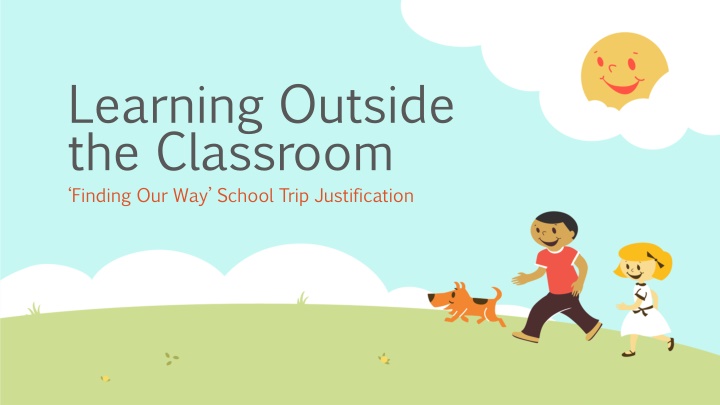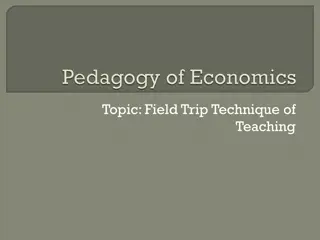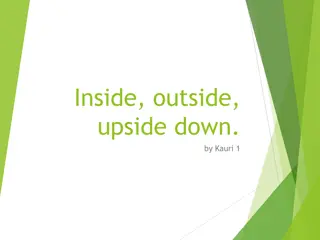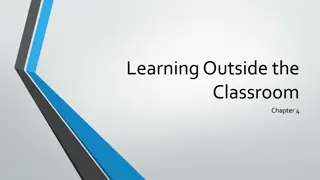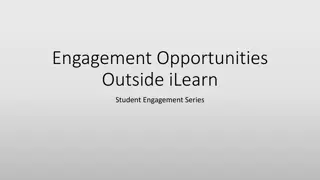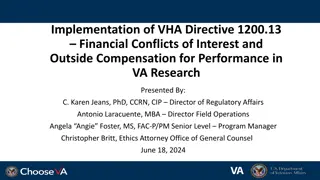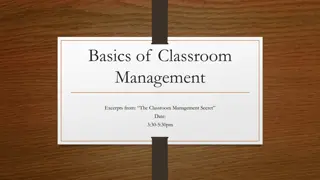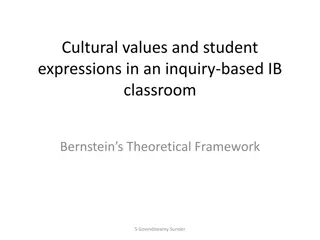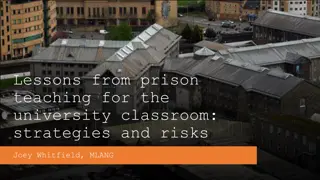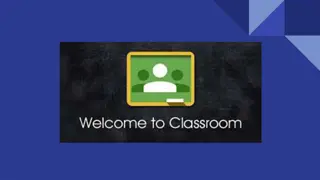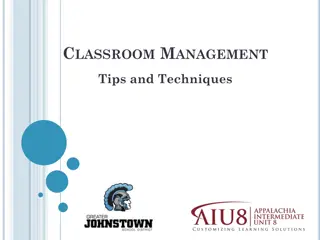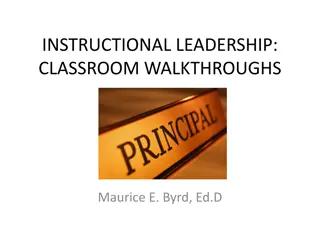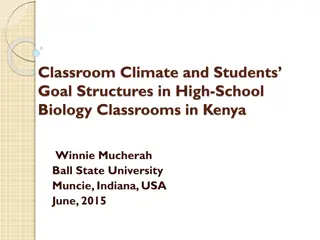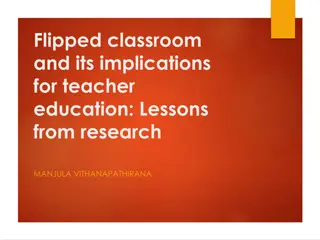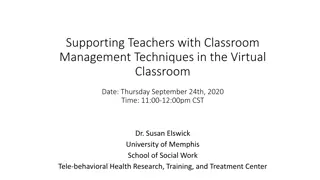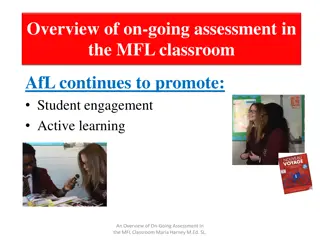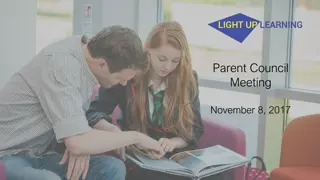Learning Outside the Classroom: Importance and Practical Application
Experimental learning through outdoor experiences is essential for holistic development. This school trip justification emphasizes the significance of hands-on learning and its practical integration with classroom teachings. The medium-term plan focuses on linking outdoor activities to further learning through reflection and team-based projects. Detailed insights into the location, resources, curriculum links, and risk assessment are provided, emphasizing a well-rounded educational approach.
Download Presentation

Please find below an Image/Link to download the presentation.
The content on the website is provided AS IS for your information and personal use only. It may not be sold, licensed, or shared on other websites without obtaining consent from the author.If you encounter any issues during the download, it is possible that the publisher has removed the file from their server.
You are allowed to download the files provided on this website for personal or commercial use, subject to the condition that they are used lawfully. All files are the property of their respective owners.
The content on the website is provided AS IS for your information and personal use only. It may not be sold, licensed, or shared on other websites without obtaining consent from the author.
E N D
Presentation Transcript
Learning Outside the Classroom Finding Our Way School Trip Justification
Contents Why do we believe it is important? How does it link to further learning? What is our plan for the day? Location Resource list Wider Curriculum Links Risk assessment and safety precautions considered
Why do we believe it is important? That which ought can best be taught inside the classroom should there be taught, and that which can best be learned through experience dealing directly with native materials and life situations outside the school should there be learned (Sharp, 1943, p.363) Experimental learning takes place using all 5 senses, this enables all children, from all ability groups to be involved in activities that are stimulating stimulating. be involved in activities that are Experience is paramount Experience is paramount; the children will learn through practically experiencing the outdoors and how they can access nature for purpose. Links to pedagogical theories on learning styles pedagogical theories on learning styles making the experience inclusive inclusive.
Medium Term Plan Linking to further learning The children will edit, present and reflect their work, giving them a sense of achievement and pride in all they have done. SCHOOL SCHOOL TRIP The children will be able to apply what they have learned and planned by carrying out their activities outside. TRIP The children will then plan their projects within a team, using team work skills and assigning roles. The children will apply this teaching practically within the classroom. The children will be given the foundational teaching.
Location Location
Ipads Clip Boards Paper and Pencils Risk assessment First aid equipment Register of children Emergency contact details for all children and staff Resources Here is a list of all resources and important documents that will need to be taken on the trip. Carrier bags to transport soundscape objects
Wider Curriculum Subjects: Geography, Art/Photography and Music
Geography Learning Objective Success Criteria. To use my knowledge of the key features of a map to read a map. To use a map to locate different locations to travel with the use of a four figure grid reference. I can explain the key features of a map. I can read a map co-ordinates to travel to different locations. Curriculum links Geography The national curriculum for geography aims to ensure that all pupils: interpret a range of sources of geographical information, including maps,. communicate geographical information in a variety of ways, including through maps. Geographical skills and fieldwork use maps and describe features studied. use the eight points of a compass, four and six-figure grid references, symbols and key (including the use of Ordnance Survey maps) to build their knowledge. Description of Main Activity Focus Using a map and co-ordinates find the different locations, and steps for the adventure. The activity is repeated between each Resources Map. Compass. Differentiation This will be evident in the outcomes, although children will be working in mixed ability groups. Important Details During this task it is important that all children remain in view and stay within given boundaries, and teachers and assistance is required to keep children constantly observed. Geography Map reading, co-ordinate work using a treasure hunt activity Structure of Lesson Teacher Role T.A. Main Teaching Instructing the children, inform of dangers of wandering off. Introduction to maps and explain how to read maps, and how to use the key/legend. Explain that the children are going on a treasure hunt and explain what they are looking for, challenge them to find the location first. Instruct of rules, eg stay within view and with set boundaries etc. Assisting with focus and control of class. This activity is repeated between each location to find the next.
Music Learning Objective To collect items that can be used to create soundscapes. To create musical instruments with natural objects. Success Criteria. I can choose items to create music from my surrounding to create a sound of the surroundings. I can create a melody with the instruments that I have found to use is when displaying my comic strip Curriculum links Music The national curriculum for music aims to ensure that all pupils: to create and compose music on their own and with others, Pupils should be taught to: improvise and compose music for a range of purposes using the inter-related dimensions of music listen with attention to detail and recall sounds with increasing aural memory Description of Main Activity Focus Looking for natural items in surrounding to create soundscapes that can be used in the presentation of the comic strips Resources iPad for each group. Differentiation This will be evident in the outcomes, although children will be working in mixed ability groups. Important Details During this task it is important that all children remain in view and stay within given boundaries, and teachers and assistance is required to keep children constantly observed. Music Using soundscapes to create atmosphere and the natural surrounding. Teacher Role Instructing the children, inform of dangers of wandering off. Structure of Lesson T.A. Main Teaching Introduce and explain the purpose of a soundscape. Demonstrate what sound can have like eg twig tapping a tree, twig rubbing between hands. Explain that has to go with the story building in art/photography lesson. Demonstrate how to record sound on iPad. Assisting with focus and control of class.
Art & Design (Photography) Learning Objective To design an adventure story and capture this adventure in photographs. To arrange the photographs into a time sequence that explains the adventure story. Success Criteria. I can create an adventure story and explain this via photographic snapshots. I can create a sequence of photographs to explain a story via a comic strip. Curriculum links Art & Design The national curriculum for art & design aims to ensure that all pupils: produce creative work, exploring their ideas and recording their experiences. become proficient in drawing, painting, sculpture and other art, craft and design techniques. Pupils should be taught to: to improve their mastery of art and design techniques. Description of Main Activity Focus Designing a story for a miniature person to have in the park, and creating sets for this person and taking photographs of it. Resources iPad for each group. Miniature person & different resources children could use eg chocolate egg, plastic dinosaurs. Differentiation This will be evident in the outcomes, although children will be working in mixed ability groups. Important Details During this task it is important that all children remain in view and stay within given boundaries, and teachers and assistance is required to keep children constantly observed. Art & Design Photography skills and comic book design Teacher Role Instructing the children, inform of dangers of wandering off. Structure of Lesson T.A. Main Teaching Introduce and explain that all have a miniature person and they need to design a story for them. Explain that need to create a set and take a photograph of the different scenes. Demonstrate the need for it to explain parts of the story and that it will be placed into a comic strip/storyboard. Refer to the story of going on a bear hunt as an example. Show resources have available. Then demonstrate how to take photographs on the iPad. Assisting with focus and control of class.
Wider curriculum links Core: Literacy and Numeracy P.E and PSHE Children will be writing down key terminology linked to photography. The children are being physically active and have to make decisions on pace and movement in order to complete the task in time. They will engage in speaking and listening skills throughout. Children will engage in team working skills, how to work well as a team and to know your strengths and weaknesses within a team. Using numbers as co-ordinates gives children a mathematical approach and relation.
Risk Assessment Risk Assessment Leaving school premises Leaving school premises - EVC approved (Senior Staff), staff pupil ratio at least 1:10. Children in 2 s, Head Count A thorough Risk Assessment has been carried out with the levels of risk clearly indicated. Low - Staff strategically positioned Loss of child in the Abington Park Loss of child in the Abington Park - Regular head counts - Low Some of the main potential risks can be seen in the adjacent box Behavior or Special Needs Behavior or Special Needs Extra supervision if Senco /EVC feels necessary. Low Follow school Behavior policy Telephone school for senior staff to fetch and return to school
Thank you for listening... Thank you for listening... Laura Casson Craig Hodge Eleanor Shackell Green Victoria Warren
